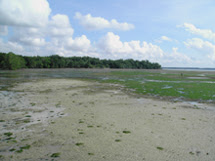As all of you should be aware of by now, the tropical grasslands of the world are home to an extremely rich variety of large mammals. Nowhere else is this diversity more apparent than in tropical Africa, where close to 50 different species of antelope, of all shapes, sizes and habits, along with numerous other large herbivores, inhabit various parts of the savannas that span the continent. And this diversity of herbivores feeds a wide variety of carnivores.
Note that not all of the creatures one can find in the savanna are 'true' savanna species; many of them actually prefer forest, but can be found in mixed habitats, such as in areas where the tropical rainforest slowly makes way for woodland, and subsequently turns into savanna. Many of these forest-dwelling animals are also occasionally found in savanna habitat adjacent to the forests where they would normally live. And some of these actually live within the savanna, wherever there is sufficient dense vegetation, bush, or thickets to hide in, such as in gallery forest, which refers to forests that grow along the banks of rivers in areas where it would otherwise be too dry for forest to grow.
By and large, however, the majority of large antelope are savanna inhabitants. Many are adapted to grazing on the grasses, herbs, and other low-growing plants. Others are browsers, choosing to nibble on tender young leaves and shoots from bushes, shrubs and trees. This way, competition between species is minimised, as each species has its own particular preference where it comes to food and habitat. The savanna may seem like a broad, homogeneous space to us, but there is a wide variety of microhabitats and ecological niches available for herbivores to exploit.
One thing that most of the larger savanna-dwelling herbivores have in common is a tendency to live in large herds. Living in large herds has its advantages, and it mostly has to do with avoiding predators. First of all, if you live in a herd, there are so many more pairs of eyes and ears on the alert for any sign of danger. Secondly, if a predator attacks, the fact that there are so many potential targets to choose from means that the likelihood of you becoming the main course for the resident lions or hyenas is so much lesser.
Due to the seasonal nature of the savanna, there are very distinct dry and wet seasons in most tropical grasslands. This has implications for the large numbers of herbivores which depend on an adequate supply of water and grazing. Many of these antelope are tough, and adapted to survive with little water and poor-quality food. These tend to stay put during the dry season. However, there are many other species which depend on having frequent access to water, and depend on tender young grass. When the dry season comes, these herbivores will migrate in huge herds, abandoning their former haunts for new pastures, travelling wherever the rain brings water and fresh green grass.
Migration is such an important part of these animals' lives that in many species, calves must learn to stand up and run with the herd within days or even hours of their birth. For wildebeest, mothers even synchronise their births as well; all will drop their calves within a short span of 2 to 3 weeks. Birth is timed to coincide with the rainy season, as well as to completely overwhelm the local predators so that overall survival rate of newborn calves is higher.
These herds may number in the thousands or even millions, all engaged in the tireless quest for food and water. Migration takes its toll, and many will perish; predators will bring down a few, whereas for others, the exhaustion and strain will be too much to bear. Where migration routes bring the herds across rivers, the death toll can be even higher, and it's not just due to the hungry Nile crocodiles that lie in wait in the water. Many of these rivers have only a few entry and exit points along the steep riverbanks, and for the thousands of hungry and thirsty herbivores, these few spots along the river banks become chokepoints. In the ensuing stampedes, many will be trampled, or drown in the waters from sheer exhaustion.
Wildebeest Migration
All over the tropical savannas of Africa, this beautiful yet harsh drama of life and death has played out for eons, with mighty herds perpetually on the move, chasing the rainclouds in a never-ending quest for fresh grass and water. Today however, many of these migrations are no more; hunting and development has decimated many of the great herds, whereas in some areas, the herds find their old migration routes blocked off with fences and development.
One of the last places where you can still see a surviving example of the great herbivore migrations is in East Africa. Here, more than a million wildebeest, and thousands of zebra and antelope make an annual journey, travelling from the Masai Mara Game Reserve in Kenya to the Serengeti National Park in neighbouring Tanzania, and back again later in the year.
Wildebeest Migration Made Simple
Serengeti Wildebeest Migration route map
This phenomenon attracts countless tourists, who pay to witness first-hand the migration of nearly 1.4 million wildebeest, 360,000 Thomson's gazelle, and nearly 200,000 zebra.
Here's a few more videos that capture the essence of life on the tropical savanna, and show us a slice of the awe-inspiring wildlife spectacle that is the Masai Mara-Serengeti migration:
Monday, 17 September 2007
Tropical Savanna: Migration of the herbivores
Labels:
geography,
natural vegetation,
tropical savanna,
videos,
wildlife
Subscribe to:
Post Comments (Atom)


2 comments:
0.o the video song nice.....
btw wat is wildebeest????
btw is wildebeest a animal o.o
I AM SUPRISE I AM THE ONI ONE HU GIV Comment N Not LovelyGirl ><"
Post a Comment